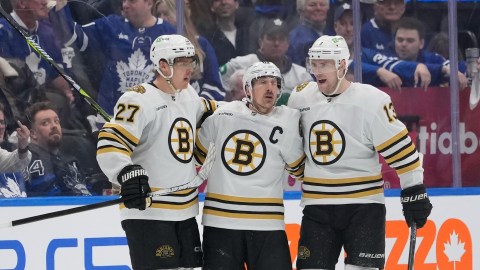Since the implementation of the salary cap, NHL general managers have struggled to figure out the perfect formula for allocating their limited funds.
While many teams have opted for a top-heavy approach, spending big bucks on a handful of top-line stars and filling out the bottom of the roster with cheaper veterans on minimum-salary deals or youngsters on entry-level contracts, the Bruins have gone with a more balanced approach.
Peter Chiarelli has still handed out big contracts to key players like Zdeno Chara, Patrice Bergeron and Tim Thomas, but he's also left a little extra for the end of his bench as well. For the second straight season, the Bruins will enter the year with a fourth line combining for cap hits just under $3 million.
That's a steep price to pay for role players, but this past year proved that it has been a wise investment. Gregory Campbell ($1.1 million cap hit), Shawn Thornton ($812,500) and Daniel Paille ($1.075 million) may have cost the Bruins a little more than most teams' fourth lines, but they've also brought a lot more to table.
"This is a line that we counted on all year," Bruins coach Claude Juilen said during the playoffs. "It's also a line that we think is one of the better fourth lines we've seen in the league. And when we need them, they are there for us."
In fact, that trio just may be the best fourth line in the NHL right now. It's hard to argue against what Thornton dubbed the "Merlot Line" in honor of their wine-colored practice jerseys. The threesome combined for 29-33-62 totals, a plus-22 rating and 284 hits last year in the regular season, and that was with Paille playing just 43 games. If Brad Marchand's numbers, prior to his move up to the second line in January, are included, the unit's totals jump to 35-41-76, plus-30 and 324 hits.
Can any other team's fourth line match that?
Detroit comes closest in terms of offensive production, with Darren Helm (12-20-32, plus-9), Drew Miller (10-8-18, minus-2) and Kris Draper (6-5-11, plus-1) always a two-way threat on the ice. They could be even more effective this year, with Patrick Eaves (13-7-20, minus-2) likely rounding out that line in place of the retired Draper.
But the Red Wings' fourth line doesn't possess anywhere near the physical dimension that Boston's trio does. Detroit's original "Grind Line" had that element when Darren McCarty was on hand for their run of Cup victories, but the current members of the line combined for just one fighting major last year and only Helm (128 hits) plays a significant role in the hitting game.
The Bruins, on the other hand, combined for 26 fights, with Thornton (10 goals, 14 fights, 141 hits) and Campbell (13 goals, 11 fights, 119 hits) two of just eight players leaguewide to reach double digits in both goals and fighting majors last season. The energy supplied by that physical play is one of the crucial elements a fourth line can provide.
Plenty of other teams have fourth lines that can add that physical element, as those lines are traditionally the domain of the enforcers and agitators. But few possess tough guys like Thornton and Campbell capable of playing a regular shift and contributing so much offensively.
Pittsburgh came closest last year with the combination of Arron Asham, Craig Adams and Michael Rupp. All three could bring the pain, with a combined 359 hits and 24 fighting majors, but each was also a solid two-way contributor as well. That line was arguably Pittsburgh's most effective in its opening-round loss to Tampa Bay in the playoffs, but the Penguins couldn't keep it together as Rupp was signed by the Rangers to a three-year, $4.5 million deal.
That just goes to show that while the Bruins may be paying more than most for their fourth line, it's still a bargain for the production they've gotten out of it.
The fourth line's performance in the playoffs illustrated that point as well. Boston's fourth line outperformed their counterparts in all four series, particularly the Flyers, when Campbell, Thornton and Paille combined for 3-4-7 totals and Philadelphia's fourth line managed just one assist and was a minus-6.
Against Vancouver in the Final, the fourth line's physical play was a key part of Boston's wearing down the Canucks over the course of that seven-game war of attrition, especially after Thornton returned to the lineup in Game 3. Paille had a goal and assist, Campbell an assist and Thornton 16 hits in five games, while Vancouver's fourth liners combined for no points and a minus-8 rating.
Julien doesn't just match those guys up against other fourth lines, though. Their abilities give him the confidence to put them out against any line and in any situation. That in turn can give the Bruins an advantage in getting their top lines out opposite other teams' fourth lines and helps keep the rest of Boston's forwards fresher. Julien's willingness to use the fourth line — even in overtime, as he did against Philadelphia in the second round — is a luxury most coaches don't have at their disposal.
"I think it helps that he puts faith in us," Paille said. "We get to play sometimes against their top three lines, so I think it helps us out in the long run to know that he has faith to put us out there."
Campbell, reflecting on the line's success after the season, agreed.
"I think [Julien] put a lot of responsibility on myself and the fourth line, which might not be every coach's tactic, but he was very good at reading the team, reading the situations in games," Campbell said. "We've always had pride in the role that we play. Obviously, it's not the most glamorous role, but that's what makes this team so good is that we have players on the team that know their role and are willing to do it."
NESN.com Bruins beat writer Douglas Flynn will be answering one question facing the Bruins this offseason each day until Aug. 8.
Tuesday, July 26: How will Joe Corvo fit into the Bruins' blue-line mix?
Thursday, July 28: What should the Bruins expect from Tuukka Rask next season, and will he be content to back up Tim Thomas for another year?



